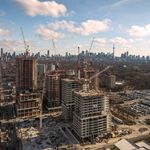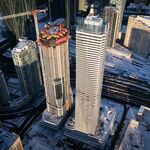Some informative comments from Schmidt about the signal system in that second article:
Gates to stop traffic and allow trains to pass through intersections shouldn't be down for more than 30 seconds and trains may not automatically get priority over other traffic.
"We could run the system that way, but that would potentially disadvantage the rest of the transportation system," Schmidt said.
I can understand not unconditionally granting priority to LRVs at signalized intersections where they'd get a green at some point anyway, but it doesn't make any sense at a level crossing where they are the only cross-traffic. Hopefully this was a misprint or misunderstanding.
Schmidt said the region wants to instead integrate train and car signals to keep [car] traffic flowing. Trains would get a priority signal only if they were behind on their route, similar to bus priority lanes on Hespeler Road in Cambridge.
According to the agreement, the system "shall allow (light rail vehicles) to be consistently served without significant delay to general traffic at signalized intersections."
I support conditional priority as a method, but this rhetoric suggests that we may be underwhelmed by the level of priority these vehicles get when the line opens.
The Waterloo spur line is an exception. What's called an automated train protection system will be installed there so while the operator is technically in control, if a red light is run the train stops automatically.
This is interesting because there's also a dedicated ROW segment in Kitchener. I guess that doesn't have ATP. Does that mean that trains won't be able to go 70 km/h like they do on the Waterloo Spur?
---
The whole article is a mess of marginally correct information. Clearly the author had only the faintest understanding of what the Region was telling them:
(tl;dr: there are lots of errors and misunderstandings).
Here, signal controls at intersections in Kitchener and Waterloo will be controlled by a computer system, Schmidt said. Train operators will be able to decide whether to stop or go at a traffic signal, the same as someone in a car or a bus driver might.
It's not like Edmonton isn't using signals controlled by computer. It's been decades since anyone has installed a clockwork controller. The issue in Edmonton was simply that the signal system wasn't working at all.
The second sentence is struggling to refer to a completely different point, which is that other than the Waterloo Spur, the ION LRT lacks signals that simply separate LRVs from one another (block signaling). The fact that operators choose to obey signals is irrelevant - I'm sure operators obey traffic signals just as much as block signals.
The average on-road speed of the trains will be about 50 km/h on the 19 kilometres of track between Conestoga Mall in Waterloo and Fairview Park mall in Kitchener.
50 km/h is the speed limit, not the average speed. The average speed is closer to 25-30 km/h.
And those 19km are the entire line, so it seems a tad unnecessary to specify.
Speeds in areas with significant pedestrian traffic such as Waterloo Town Square or for pulling into stations will be slower, but in less congested pedestrian areas speeds could be increased to about 70 km/h, Schmidt said.
It's not about pedestrian congestion, it's about fully dedicated ROW or not. In the segments with 70 km/h limits, it's basically a train. In the segments with 50 km/h limits, it's basically a streetcar.
The full round trip from Conestoga Mall to Fairview Park mall in Kitchener and back is expected to take about 95 minutes.
Who cares? The round trip time includes the layovers at either end, so it's irrelevant to everyone other than the operators and schedulers. Now we'll end up with a bunch of citizens whining about how we're spending kajillions of dollars on a line that takes an hour and a half just to get to Kitchener.




